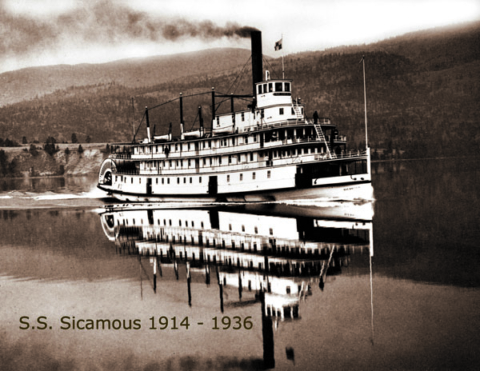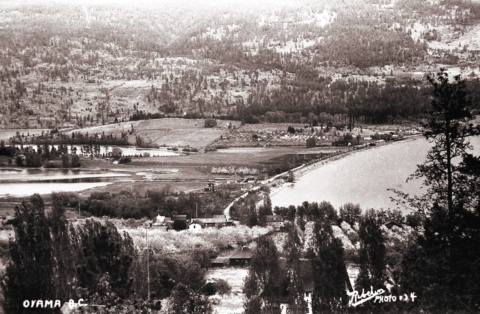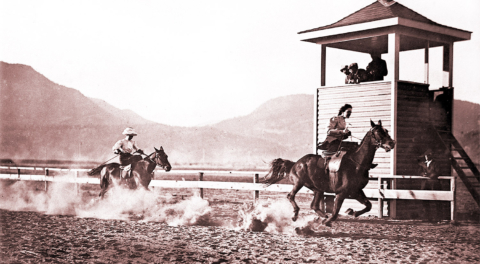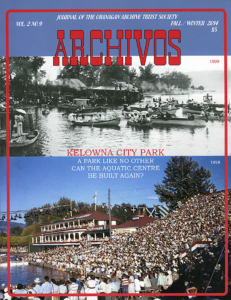
Editorial by Brian Wilson ©2014
Back in April 2014, long-time Kelowna resident and business man, Don Burnett put forward a plan to rebuild the Kelowna Aquatic Centre in City Park. It burned in 1969 and was never rebuilt.
The photos here are quite explicit in depicting the long and successful history of the Aquatic Club and it’s evolution.
Why was City Park dedicated to public use all those years ago? It was underwater for three month each year, that’s why..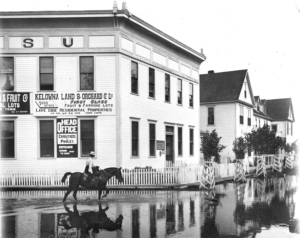 Water Street is aptly named as it was the high water mark of the era prior to drainage controls.
Water Street is aptly named as it was the high water mark of the era prior to drainage controls.
By June each year, water had subsided and events could be planned next to the Government Wharf at the foot of Bernard. The first events were planned as part of the Annual Fall Fair that took place at the grounds at the foot of Knox Mountain.
As this was an affluent community of British Colonialists, there were a lot of boats and boating competitions. The first gas-powered competition took place in 1905. George Rose, editor of the local paper took it on himself to organize the first summer festival in 1906 and in August that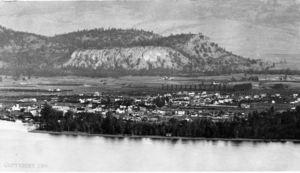 year, the first Regatta was held.
year, the first Regatta was held.
The Fall Fair continued on it’s dates as well with horse-racing, polo, steeplechase and the usual produce displays.
There was lots to do and everyone in town attended. George sold shares in the newly formed Aquatic Association and raised $10,000 to build the first pavilion to seat 800. In 1910, the Regatta became a two-day affair.
In 1920 a thirty four foot extension to the grandstand was built and the Aquatic building soon became a centre for year round dances and fundraising events.
In 1930, the first Pageant was held and in 1931 the first Regatta Queen was crowned. The event was re-named “Lady of the Lake” in 1934. These ladies were crowned on a large floating stage at the grandstand.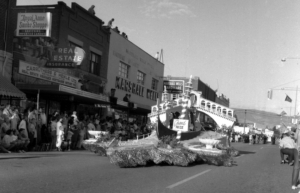 It wasn’t until after the war that the first parade was held. As with Penticton, the first was 1947 and it was a tremendous success. The Kinsmen Club and later the JCs organized a real crowd pleaser.
It wasn’t until after the war that the first parade was held. As with Penticton, the first was 1947 and it was a tremendous success. The Kinsmen Club and later the JCs organized a real crowd pleaser.
Kelowna’s long-time Mayor; Dick Parkinson was involved in Regatta from 1931 on and became known as “Mr. Regatta” for his participation in innovative changes that made Regatta a tourist draw.
The park facilities were remodeled in 1954 with the addition of the Ogopogo Stadium and Pool. This new grandstand made possible huge championship events such as National swimming, diving and rowing.
Then in 1969 the stadium burned down. On July 13, a fire started under the grandstand and quickly became an inferno that devastated the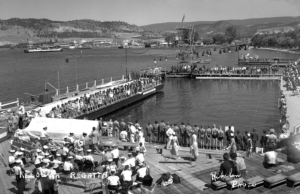 Association and the city. It was decided to not rebuild it and to change the theme of Regatta away from a community event to a tourist draw.
Association and the city. It was decided to not rebuild it and to change the theme of Regatta away from a community event to a tourist draw.
I must note here that Commonwealth and Olympic athletes, the Athans Brothers were the favourites of many of the water events. Greg was a champion water-skier with his brother George. Their father, George Sr., was a champion diver and their mother, Irene, was a synchronized swimmer and speed swimmer. Younger brother Gary, was an Olympic 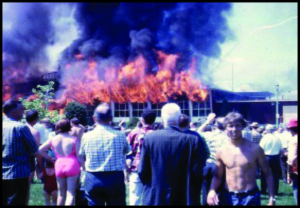 competitor in downhill skiing. These were the champions raised in the pool at the Aquatic.
competitor in downhill skiing. These were the champions raised in the pool at the Aquatic.
The Ogopogo Pool and wharves remained useable after the fire and remained an integral part of the venue until late 70s.
Large tourist events were advertised all over the Pacific Northwest to draw people to Kelowna for that weekend. World-class hydroplane races and air shows worked wonders to draw a generous visitor to Kelowna during the 60s and 70s. But all that spelled the end to the feeling of a small-town community festival.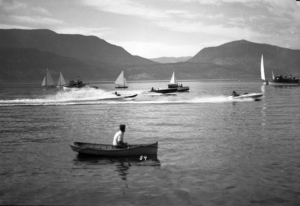
As the stage and boardwalk became unsafe the venue was changed to the lakefront a little north of downtown. Regatta continued to grow, but it grew away from city park. The physical focus of City Park was greatly diminished.
By mid-eighties, the Regatta was an international event with air shows and hydroplane races, but few community oriented events. Organizers continued to promote “bigger and better” ideas to attract younger adults and their generous spending.
The Regatta of 1986 brought the first riot. 105 people were arrested, 68 from out of town.
The next year was a repeat and that was the end of the Regatta forever.
Don Burnett and Brian Sprout, in their analysis, know that part of the problem of the use of the park, is the lack of a core facility that the community can identify with. What Kelowna needs to embrace, Don remarked, is a full-time, year round pavilion and pool that becomes a destination for local families. An Arts, Heritage and Culture centre for a vast number of diverse events that cause a natural evolution of ever increasing use. A grandstand and pool would replace the long-gone outdoor pool with the only Olympic size pool in the valley. Don has an idea to heat the surrounding water with geothermal for a longer season.
Grandiose idea? Sure. But it’s a start at creating something the growing population can call their own and bring competitive water sports back to Kelowna.

